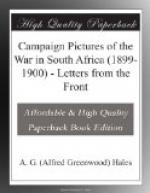By the light of my lantern I saddled my horse, and snatched a hasty cup of coffee and a mouthful of biscuit, and as the little band of Tasmanians moved from Rensburg I rode with them. Where they were going, or what their mission, I did not know, but I guessed it was to be no picnic. The quiet, resolute manner of the officers, the hushed voices, the set, stern faces of the young soldiers, none of whom had ever been under fire before, all told me that there was blood in the air, so I asked no questions, and sat tight in my saddle. As the daylight broke over the far-stretching veldt, I saw that two other correspondents were with the party, viz., Reay, of the Melbourne Herald, and Lambie, poor, ill-fated Lambie, of the Melbourne Age. For a couple of hours we trotted along without incident of any kind, then we halted at a farmhouse, the name of which I have forgotten. There we found Captain Cameron encamped with the rest of the Tasmanians, and after a short respite the troops moved outward again, Captain Cameron in command; we had about eighty men, all of whom were mounted.
As we rode off I heard the order given for every man to “sit tight and keep his eyes open.” Then our scouts put spurs to their horses and dashed away on either wing, skirting the kopjes and screening the main body, and so for another hour we moved without seeing or hearing anything to cause us trouble. By this time we had got into a kind of huge basin, the kopjes were all round us, but the veldt was some miles in extent. I knew at a glance that if the Boers were in force our little band was in for a bad time, as an enemy hidden in those hills could watch our every movement on the plain, note just where we intended to try and pass through the chain of hills, and attack us with unerring certainty and suddenness. All at once one of our scouts, who had been riding far out on our left flank, came flying in with the news that the enemy was in the kopjes in front of us, and he further added that he thought they intended to surround our party if possible. Captain Cameron ordered the men to split into two parties, one to move towards the kopjes on our right; the other to fall back and protect our retreat, if such a move became necessary. Mr. Lambie and I decided to move on with the advance party, and at a hand gallop we moved away towards a line of kopjes that seemed higher than any of the others in the belt. As we neared those hills it seemed to us that there were no Boers in possession, and that nothing would come of the ride after all, and we drew bridle and started to discuss the situation. At that time we were not far from the edge of some kopjes, which, though lying low, were covered with rocky boulders and low scrub.




